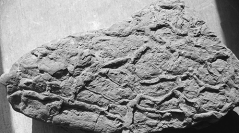

 Comptes Rendus Palevol
10 (8) - Pages 617-625
Comptes Rendus Palevol
10 (8) - Pages 617-625New tetrapod footprints belonging to the ichnogenus Hyloidichnus have been discovered in Turkey for the first time, in the lower part of the Çakraz Formation (Northwestern Anatolia) and together with macrofloral imprints of Annularia and Stigmaria. These discoveries confirm the Permian age of the fossiliferous red beds in which the coniferophyte Walchia was previously recorded. Based on the stratigraphic range of Annularia, Stigmaria and Hyloidichnus known elsewhere, a Cisuralian age is proposed for these beds. These new ichno- and macrofloral remains, together with the sedimentological data (mudcracks, rain drops) suggest the presence of captorhinid reptiles living in a palustrine floodplain environment, and under a warm, seasonal climate alternating between humid and relatively long dry seasons. These climatic conditions may have permitted the migration of these captorhinids through Laurasia during the Permian.
Ichnites, Hyloidichnus, Annularia, Stigmaria, Pangaea, Captorhinid, Migration, Turkey